This year, teacher walkouts and protests in seven states highlighted the chronic disinvestment in U.S. K-12 classrooms. Accompanied by a successful social media campaign, these protests had Americans all over the country asking why public school teachers are not paid enough to support their families, why students are using dilapidated textbooks, and why students are attending crumbling schools.1
The answer to these questions is that, on the whole, far too many states have systematically disinvested in K-12 funding in the wake of the 2008 Great Recession. These cuts affect school inputs, from teacher salaries to student resources; they also have significant impacts on critical outcomes such as student achievement. In the decade-long recovery that has followed the recession, only a handful of states have returned to pre-recession levels of spending. The majority continue to spend less on education than they did 10 years ago. Some states have even chosen to cut taxes during the recovery rather than invest in education by raising spending back to 2008 levels.2
This issue brief first presents data on the chronic underinvestment in schools since the Great Recession. It then explores research demonstrating that investment in K-12 education benefits students, as well as research on the impact that underinvestment is having on schools’ most important resources—teachers and students. Finally, the brief discusses how state and federal policymakers can prioritize this issue.
States have made deep cuts to K-12 education since the recession
As mentioned above, due to dramatic revenue losses, state funding for K-12 education fell sharply after the Great Recession, and despite experiencing one of the longest recoveries on record, most states have funding levels that continue to lag behind. In fact, most states are still spending less per pupil than they were in 2008.3
On average, 47 percent of K-12 education funding comes from state revenue, while local government provides 45 percent, and the federal government provides the remaining 8 percent.4 Because schools depend on state funding for about half of their revenue, they must drastically cut spending when states provide less—especially when local districts cannot cover the gap. Over the past decade, states with the steepest funding declines have seen one-fifth of state education funding vanish.
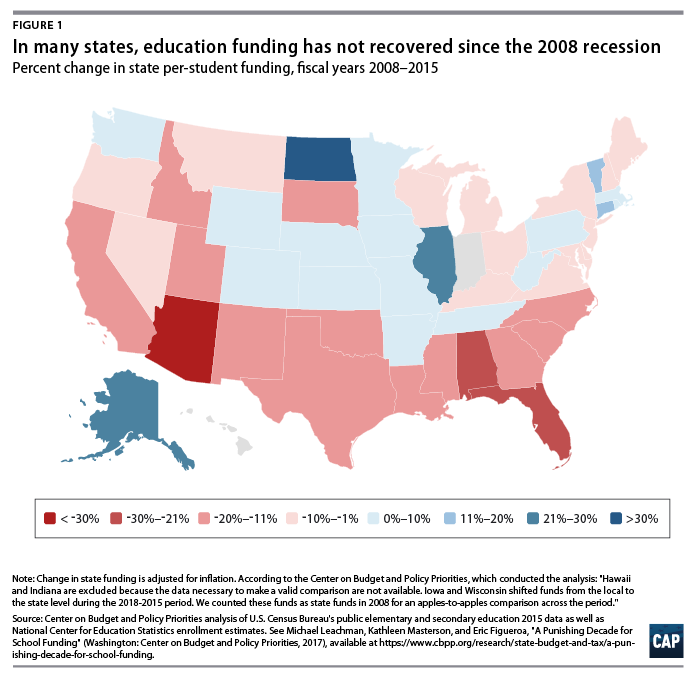
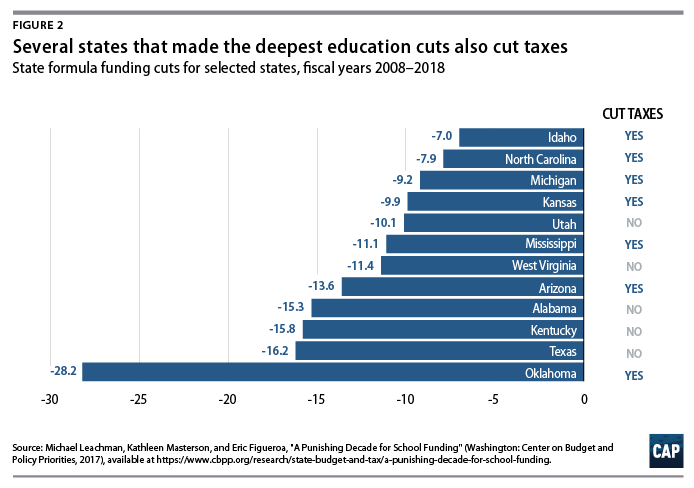
Some of these cuts, particularly those made immediately following the recession, were a result of economic forces outside of states’ control. Once revenue began to rebound, however, many states enacted massive tax cuts that deprived state governments of revenue needed to increase education spending. In recent years, seven of the 12 states that have made the deepest funding cuts since 2008 chose to cut taxes rather than reinvest in education: Arizona, Idaho, Kansas, Michigan, Mississippi, North Carolina, and Oklahoma.5 Notably, in spring 2018, three of these seven states—Arizona, Oklahoma, and North Carolina—experienced teacher walkouts in protest of insufficient education funding and low teacher salaries. The first state to have a walkout, West Virginia, had not made tax cuts but still had some of the deepest funding cuts in the nation.
Although the federal investment in education has always provided a small proportion of overall funding compared with state and local investments, the Trump administration has nonetheless sought to disinvest in education. In its budget requests for fiscal years 2018 and 2019, the Trump administration attempted to decrease federal spending for K-12 education.6 In the FY 2019 budget request—and just after enacting significant tax cuts for the wealthy—the administration suggested slashing funding for teachers and after-school programs, essentially requesting that teachers and students foot the bill for the tax cuts in the form of increased class sizes and canceled extracurricular and enrichment programming.7
Money matters in education
For years, some policymakers and conservative education advocates have argued that spending more money on education does not necessarily improve results—and they have used this claim as an excuse to cut funding.8 Recently, however, more and more evidence is casting serious doubt on this position. Indeed, money matters a great deal, particularly for students from low-income families.
Historical increases in education spending—especially during the 1990s, when many states changed their school finance formulas—are associated with improved educational outcomes. A study on the effect of court-ordered increases on per-pupil spending, for example, found a positive correlation with student graduation rates.9 Court-mandated reforms tended to increase spending in higher-poverty districts and allocate more resources to districts based on observable indicators of student need, such as free lunch eligibility and the enrollment of students of color.
Similarly, research indicates that greater state spending on low-income students leads to improvements in student learning in reading and math.10 One 2018 study connected state funding reforms to National Assessment of Educational Progress (NAEP) data in low-income school districts between 1990 and 2011. It found that the NAEP test score gap decreased in states that passed school finance reforms to make funding more equitable but remained the same in states that did not.
Another 2018 analysis indicates a correlation between cumulative per-pupil spending and NAEP scores.11 The analysis also found that states with larger recessionary budget cuts experienced a decline in testing and student achievement. A 10 percent school spending cut, for example, reduced NAEP test scores by 7.8 percent of a standard deviation and reduced graduation rates by 2.6 percentage points.12
There are large differences among states in educational spending and quality, with the highest-performing states tending to have high spending. The states ranked highest on Education Week’s 2017 Quality Counts K-12 achievement index have per-pupil spending well above the national average of $11,454. Even when accounting for cost of living, most of these states are still spending far above the national average—with the exception of Maryland, where the high cost of living means that spending is still above, but closer to, the national average.13 Although high spending does not always translate into high performance or vice versa, spending tends to be much lower among the lowest-performing states on the Quality Counts index.14
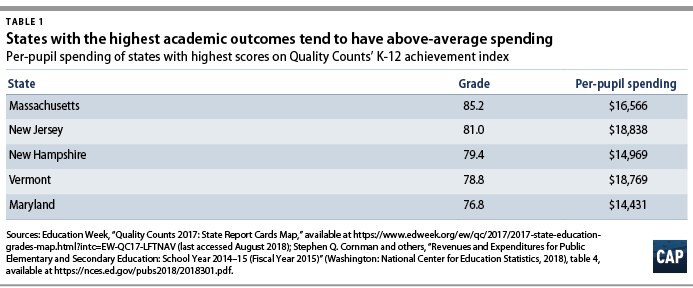
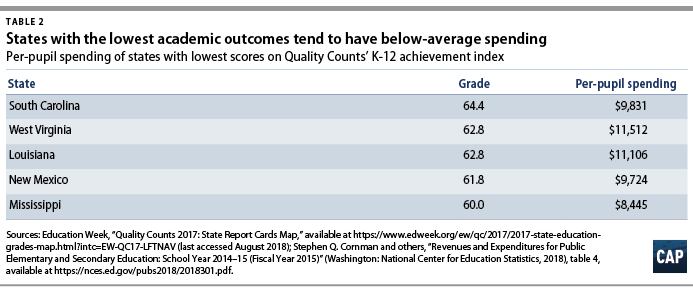
Additional research points to the impact of education spending on students’ future earnings. Research examining the relationship across districts between per capita income and per-pupil expenditures on students who are now adults and earning income found a correlation between improving school finance equity and the intergenerational income mobility of low-income students.15 The study also explored how equalizing revenue is associated with reduced disparities across high- and low-income districts, including disparities in teacher-to-student ratios.
A recent study quantified this intergenerational mobility effect, finding that a 10 percent increase in per-student spending was associated with an increase in low-income students’ adult wages by about 7 percent, as well as a 3 percent lower poverty rate.16 Both this and the earlier study found correlations between specific inputs that were made possible through increased funding—such as raising teacher salaries and lengthening the school day—and student achievement.
Lack of funding means low salaries for teachers
Cuts to education spending affect all aspects of students’ academic experience, from the condition of the school building to the courses offered and the teachers in the classroom. In fact, teacher salaries and benefits account for the majority of public school spending. As of 2015, salaries and benefits accounted for about 80 percent of per-pupil expenditures—including the salaries and benefits of teachers, administrators, and other staff.17 It is not surprising, then, that in this decade of brutal cuts to education funding, teachers are feeling the squeeze.
Teacher salaries have been stagnant for the last 20 years. In fact, from 1996 to 2015, the average weekly wages of public sector teachers decreased $30 per week, from $1,122 to $1,092 in 2015 dollars.18 During this same time period, the weekly wages of all college graduates rose from $1,292 to $1,416. As a result, teachers’ weekly earnings are now 23 percent lower than those of other college graduates.
Furthermore, midcareer teachers often struggle to afford a home and pay for basic necessities, especially if they live in high-cost areas. Many take on second jobs to support their families, and those who are breadwinners often qualify for a number of means-tested assistance programs as a result of their low salaries.19 In a study of 113 large public school districts, researchers found that it can take nearly 25 years, on average, for teachers to earn a yearly salary of $75,000.20 Because teachers’ salaries tend to be higher in states where unions are stronger, the recent ruling in Janus v. American Federation of State, County, and Municipal Employees (AFSCME), which is expected to shrink and weaken unions, could mean teacher pay will lag even further.21
Declining salaries and underfunded schools may be one explanation for the precipitous drop in the enrollment numbers of teacher preparation programs since 2008. While the exact cause of the decline is not yet known, enrollment in these programs is down 39 percent since 2008. Over this time period, schools have made not only recession-related funding cuts but also significant layoffs that have disproportionately affected new teachers.22
As a result of both state disinvestment and declining interest in the teaching profession, some of the worst-funded states—including Arizona and Oklahoma—are suffering from acute teacher shortages. In many cases, this has led states to revert to substitute and emergency credentials in order to ensure that students have someone—no matter how unqualified—in front of their classrooms.23
Studies demonstrate that there is a link between teacher pay and student outcomes. A 2011 study comparing teacher pay and student outcomes theorized that paying teachers a higher wage attracts new teachers, which promotes competition and, in turn, higher-quality applicants.24 The researchers found a correlation between higher pay and student performance across countries. Figure 3 illustrates a similar correlation.
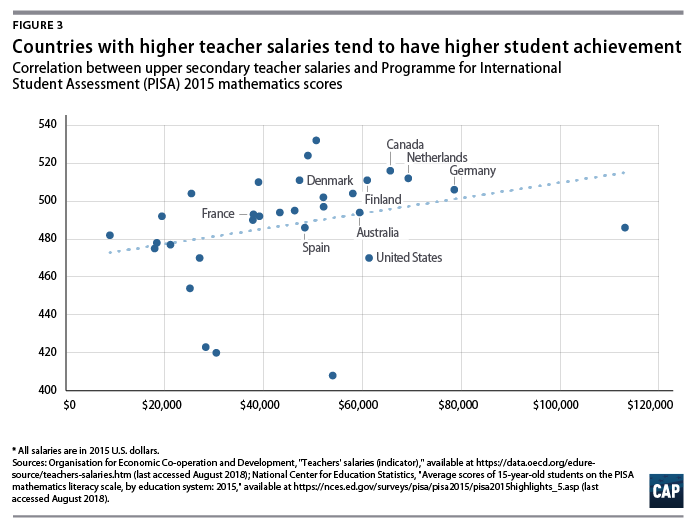
Furthermore, a natural experiment that occurred in England, which isolated the impact of teacher pay, found that student academic performance suffers when teachers are paid below market rates.25 U.S. research, meanwhile, showed that the inverse is also true. A meta-analysis of studies that isolated the impact of merit-pay programs for teachers found that when teachers were able to earn more based on performance, there was a statistically significant improvement in student achievement.26 An additional study of Texas teachers found that teacher pay may also increase student achievement because it is correlated with reduced turnover.27
Lack of funding means an inability to invest in what matters for students
In addition to providing resources for higher teacher pay, there is a range of ways in which greater spending is likely to positively affect student achievement. Poor school conditions, for instance, can have negative effects on student learning. Research indicates that poor air quality or lighting, uncomfortable temperatures, and excessive noise can all impede student learning.28 A study of New York City middle schools found that, among other aspects of the physical and social environments, the building condition was a contributing factor to academic performance.29 Every student should be able to learn in a safe and comfortable environment. But more than half of U.S. public schools are in need of repairs.30 The U.S. Department of Education estimates that deferred maintenance and repairs alone would cost about $200 billion.31 Investing in crumbling school buildings and updating facilities would indicate that communities value student learning.
Hiring additional instructional coaches for teachers can also improve student achievement. Research indicates that high-quality coaching programs—especially content-specific programs—can help teachers not only improve students’ test scores but also support students’ social and emotional development.32 Effective coaching requires more than a few professional development days or workshops; it must include coaches’ observations of teachers, scheduled time for feedback from coaches, and training of master coaches who support and train other coaches—all of which require significant investment. Similarly, providing trained mentors for new teachers may significantly boost student achievement. One 2017 study looked at two school districts where some new teachers received up to 100 hours of training a year and met with mentor teachers once a week. It found that the new teachers who received these supports saw improved student achievement and higher student standardized test scores than the teachers who received more limited support.33 Another personnel-related intervention is class-size reduction, which, according to some research, is correlated with increased student achievement.34
In addition, specialized pupil support services personnel, such as school psychologists and social workers, help to reduce many of the barriers that hinder student success. Mental health and behavioral issues—including delinquency, attention difficulties, and substance abuse—are significantly associated with lower achievement.35 Research indicates that psychological distress and depression may increase the likelihood of homework trouble, absenteeism, and course failure.36 Likewise, experiencing trauma such as violence or abuse is associated with lower standardized test scores, not just for the students who experience trauma but also for their classmates.37 Nevertheless, many students’ mental health needs go unmet, as school-based mental health professionals are operating far below recommended ratios.38 Investing in additional specialized pupil support services personnel can address student needs that interfere with learning.
Investing in content-rich, varied, high-quality curriculum can also lead to significant gains in student achievement. Research shows that instructional materials can have an impact equal to or greater than the impact of teacher quality.39 While curriculum quality is not solely measured by cost, adopting new curricula requires significant investments in resources and educator training.40
Conclusion: Prioritizing investment in education
Since the Great Recession, many states have systematically disinvested in education. This has affected all aspects of school quality, from teachers to school environment to instructional materials used in the classroom. By underfunding schools year after year, too many states are doing a great disservice to their students—and they are potentially harming the nation’s long-term economic potential. States should increase funding for K-12 public schools. In addition, the federal government can play a role in investing in teacher pay, first, by rejecting administration efforts to cut funding and, then, by expanding existing funding streams. It can also bring forward any of a number of proposals to improve teacher compensation that have recently been introduced in Congress.41 If education is truly to be an engine of opportunity and economic mobility, states and the federal government must invest far more in the communities that need resources most.
Lisette Partelow is the director of K-12 Strategic Initiatives at the Center for American Progress. Sarah Shapiro is a former research assistant for K-12 Education at the Center. Abel McDaniels is a former research associate for K-12 Education at the Center. Catherine Brown is the vice president of Education Policy at the Center.